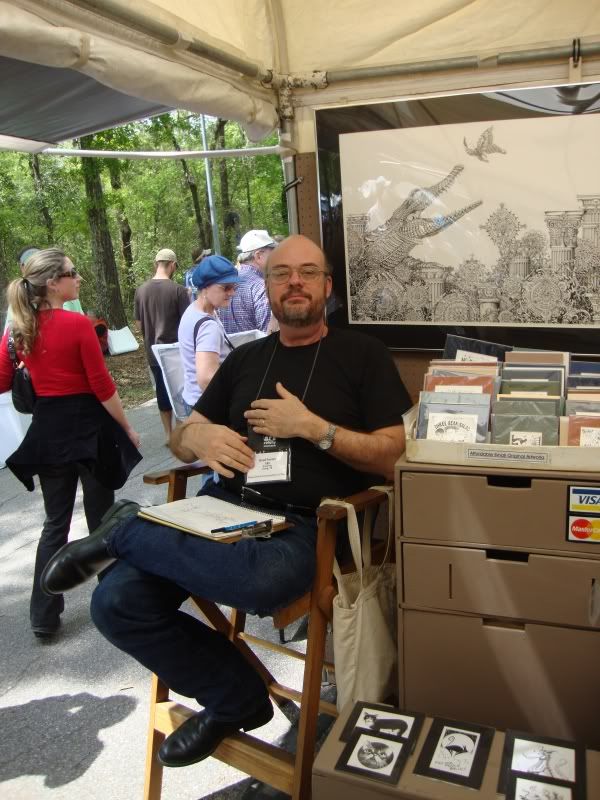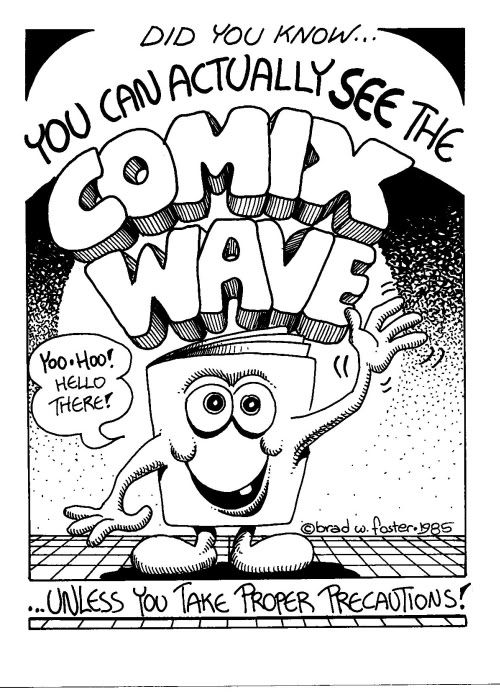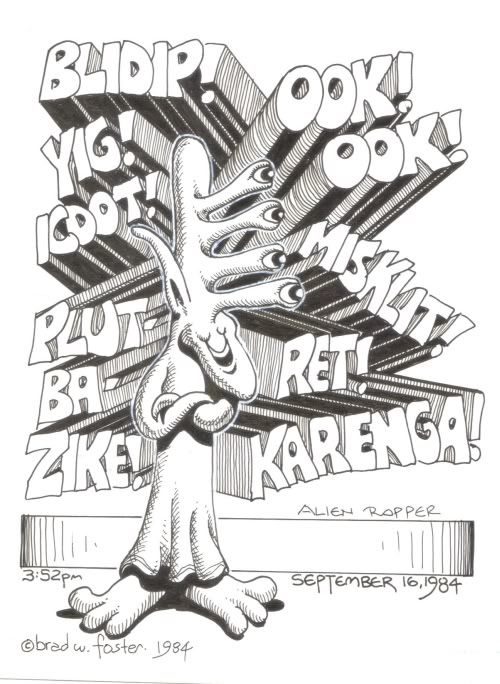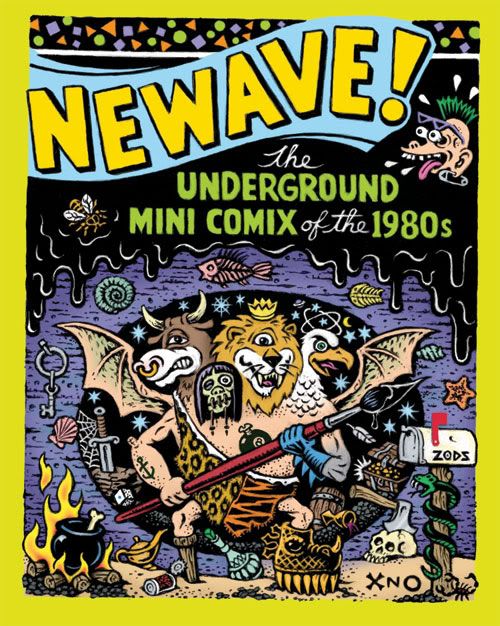
As you can see from the piece to Foster's right in this photo, the artwork Foster was displaying was anything but "mini." But it retained a relationship with his minicomics art by virtue of it being black and white, highly detailed, and stippled. You can see a lot of his work on his website, Jabberwocky Graphix. Now it turns out in the pre-internet of the 80s, I ordered minis from Jabberwocky (or else from some other mini-distributor who was carrying this stuff), including all the issues of Our Story Thus Far, a giant "jam" mini with more than 80 artists adding to the story, bit by bit. (These are still available from Foster.)
Also on his site, you will see his schedule of appearances. He goes to a lot science fiction cons and one anime con (no comics cons, weirdly enough), but mostly he goes to juried art festivals like the Bayou City Art Festival. Now the key word here is "juried." From the way that Foster (and some of the other artists I spoke to) described it, the jury is judging you on your art, but also on your ability to put together a decent booth. These booths are fancy, and I presume getting one together is expensive. Foster mainly goes to juried festivals that are with driving distance of the Dallas/Fort Worth area, but other artists seem to go all around the country.
I had been to "art" festivals up in Seattle before, but I have to say that they seemed more like "craft" festivals. (Back then, it was really popular for exhibitors to make cheesy sculptures out of Mount St. Helens volcanic ash, for some reason.) But as I said, this festival--even though it included a lot of "craft" items (like the marbled tie and hand-carved wooden toys I bought), it was mostly about people working in artforms that have since the Renaissance been classed as high art--painting, drawing, sculpture--and related artforms like printmaking.
Who is on the jury for these things? I dunno (but have asked). How do they pick stuff? How do artists get hooked into this network? It seems that these festivals form an art promotion and marketing apparatus that is fairly distinct from the gallery system (although I am sure there is some overlap). The Festivals have their own gatekeepers (the juries) and their own economies. And, perhaps most important, their own aesthetics. If you were a sociologist writings about the socio-economics of art in America, you simply would have to discuss the festivals. I'd be extremely interested in knowing how much revenue was generated in those three days from art sales.
The weird thing about Foster is that he comes to the Festivals--a kind of alternative art world--from another alternative world, the world of minicomics. I've written about minicomics before on this blog. And in the 90s, I wrote a column for The Comics Journal called "Minimalism." Minicomics were and still are important places for cartoonists to develop their work. But in the 80s, the culture took on a life of its own, where the minicomic format was the goal. There was a non-commercial ideology at work (it didn't have the overt anti-capitalism of other non-commercial art movements, but it did share a certain suspicion of and contempt for larger, for profit operations). The godfather of this movement was an old hippie from Berkeley named Clay Geerdes. He had come out of the world of underground/alternative journalism and somehow hooked up with some young cartoonists who showed uplate for the underground comix party (which, by the late '70s, was pretty dead). Geerdes wrote up a manifesto in 1983 and started publishing his Comix Wave and Comix World series and acting as a central clearing house, connecting artists all around the country to each other. (Another big catalyst was the publication of Factsheet Five starting in 1982.)
Amazingly enough, Foster had some of his minicomics art there. So I bought some.

Brad Foster, Comix Wave cover, ink on paper, 1985
This is a cover he did for Clay Geerdes' Comix Wave (obviously). I thought having it would be having a little piece of minicomics history.

Brad Foster, Alien Rapper, ink on paper, 1985
Foster was astonished to have a customer who knew minicomics. I was astonished to see him in this setting--but delighted--to see him in this setting.
If you want to know more about the history of minicomics, I suggest picking up a copy of Newave!, the huge (892 pages) yet tiny (5" x 6 1/4") anthology of the best minicomics from the 80s. Foster has a lot of work there.

Of course, also check out Foster's website and I'd also recommend taking a look at the Poopsheet Foundation.




No comments:
Post a Comment